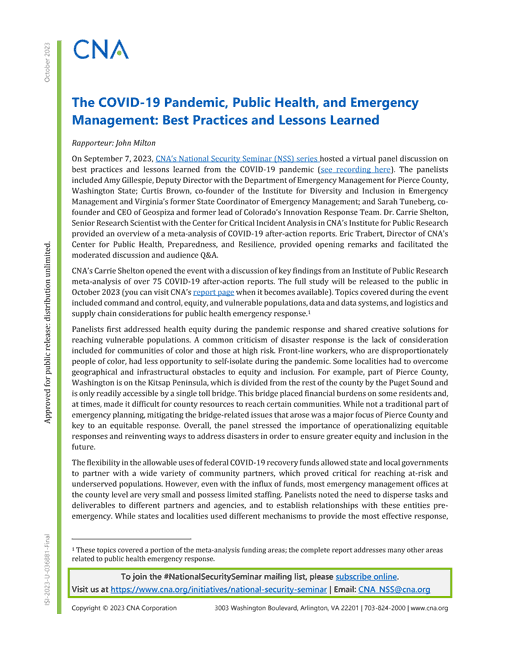On September 7, 2023, CNA’s National Security Seminar (NSS) series hosted a virtual panel discussion on best practices and lessons learned from the COVID-19 pandemic (see recording here). The panelists included Amy Gillespie, Deputy Director with the Department of Emergency Management for Pierce County, Washington State; Curtis Brown, co-founder of the Institute for Diversity and Inclusion in Emergency Management and Virginia’s former State Coordinator of Emergency Management; and Sarah Tuneberg, co-founder and CEO of Geospiza and former lead of Colorado’s Innovation Response Team. Dr. Carrie Shelton, Senior Research Scientist with the Center for Critical Incident Analysis in CNA’s Institute for Public Research provided an overview of a meta-analysis of COVID-19 after-action reports. Eric Trabert, Director of CNA’s Center for Public Health, Preparedness, and Resilience, provided opening remarks and facilitated the moderated discussion and audience Q&A.
CNA’s Carrie Shelton opened the event with a discussion of key findings from an Institute of Public Research meta-analysis of over 75 COVID-19 after-action reports. The full study will be released to the public in October 2023 (you can visit CNA’s report page when it becomes available). Topics covered during the event included command and control, equity, and vulnerable populations, data and data systems, and logistics and supply chain considerations for public health emergency response.
Panelists first addressed health equity during the pandemic response and shared creative solutions for reaching vulnerable populations. A common criticism of disaster response is the lack of consideration included for communities of color and those at high risk. Front-line workers, who are disproportionately people of color, had less opportunity to self-isolate during the pandemic. Some localities had to overcome geographical and infrastructural obstacles to equity and inclusion. For example, part of Pierce County, Washington is on the Kitsap Peninsula, which is divided from the rest of the county by the Puget Sound and is only readily accessible by a single toll bridge. This bridge placed financial burdens on some residents and, at times, made it difficult for county resources to reach certain communities. While not a traditional part of emergency planning, mitigating the bridge-related issues that arose was a major focus of Pierce County and key to an equitable response. Overall, the panel stressed the importance of operationalizing equitable responses and reinventing ways to address disasters in order to ensure greater equity and inclusion in the future.
The flexibility in the allowable uses of federal COVID-19 recovery funds allowed state and local governments to partner with a wide variety of community partners, which proved critical for reaching at-risk and underserved populations. However, even with the influx of funds, most emergency management offices at the county level are very small and possess limited staffing. Panelists noted the need to disperse tasks and deliverables to different partners and agencies, and to establish relationships with these entities pre-emergency. While states and localities used different mechanisms to provide the most effective response, all panelists agreed that the flood of flexible federal funds was beneficial for plan implementation and recovery.
The panel also addressed the role of elected officials in pandemic response efforts. Their involvement can often be a double-edged sword for responding agencies: elected officials can be advantageous when they are data informed, in-line with health authorities, and knowledgeable of the jurisdiction’s pre-existing response plans, but at other times, they can be counterproductive or even detrimental to a jurisdiction’s emergency response efforts. “They can definitely be helpful, in terms of public outreach and building trust with the community, but quite honestly, they can also derail years of planning that has gone into preparing for these large-scale events,” stated Curtis Brown. Other panelists stressed the importance of preparing elected leaders ahead of disasters. Sarah Tuneberg added, “I don’t contemplate a world where elected officials are going to be enthusiastic to prepare for unlikely events, but they will be really excited to be involved when they happen.” Panelists noted that involving elected officials in planning and exercises can be helpful, and that emergency managers should also be prepared for elected officials to have different priorities.
Finally, panelists shared lessons learned for securing PPE through global supply chains, which yielded a variety of new opportunities for public and private partnerships. As states were competing for limited federal resources from the Strategic National Stockpile, emergency management agencies began looking to both domestic and international private industry for innovative solutions to fill gaps. Colorado, for instance, secured new supplies of PPE from South Korea, and Pierce County partnered with a variety of private firms to assist with delivery and testing, ranging from large corporations like Amazon to small Seattle start-ups. New scalable structures have since been codified in law, further strengthening public and private partnerships to better prepare for future recovery and mitigation efforts.
Download reportApproved for public release: distribution unlimited.
Details
- Pages: 2
- Document Number: ISI-2023-U-036881-Final
- Publication Date: 10/10/2023
